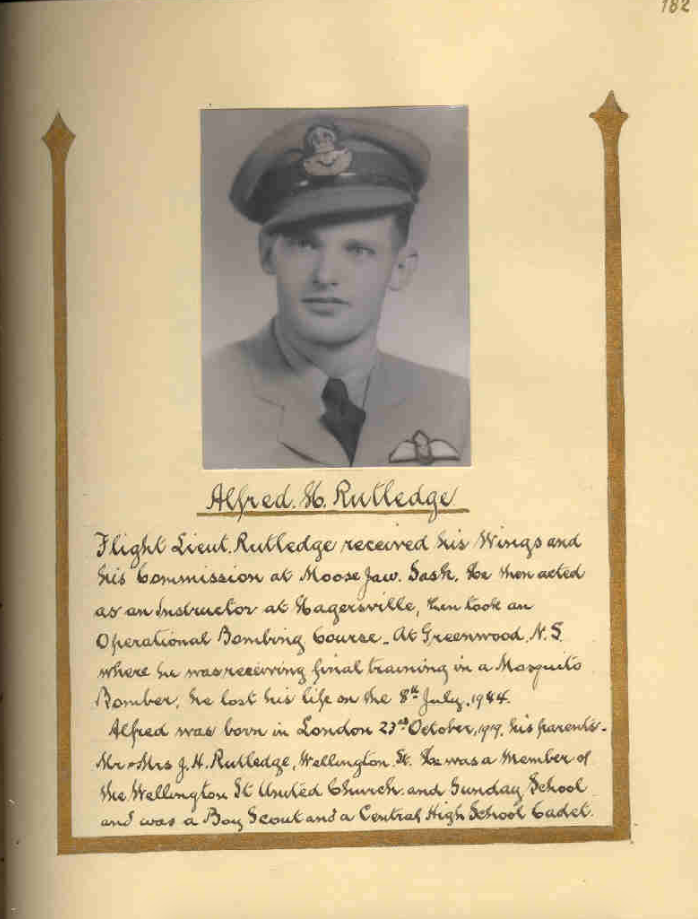
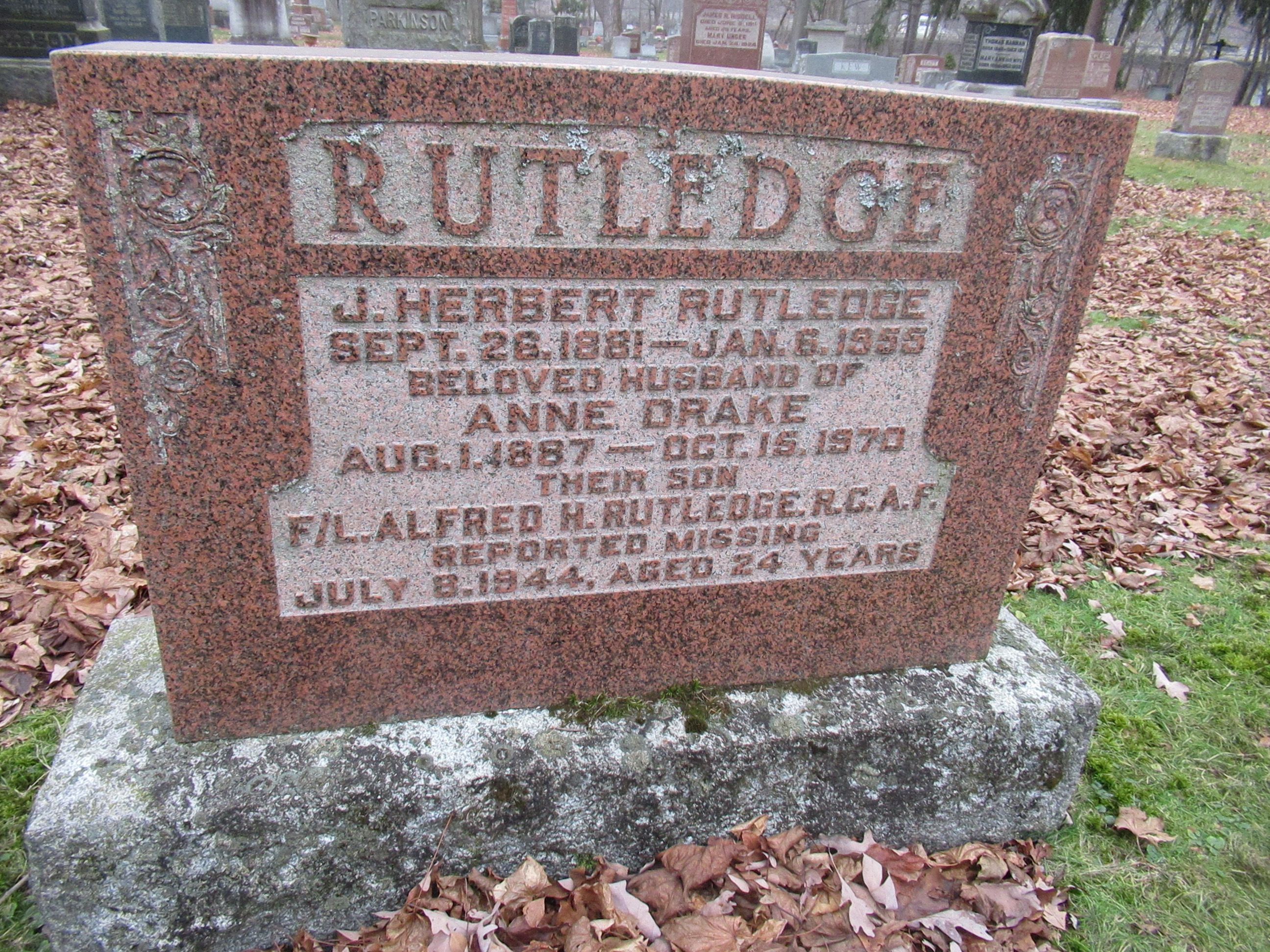
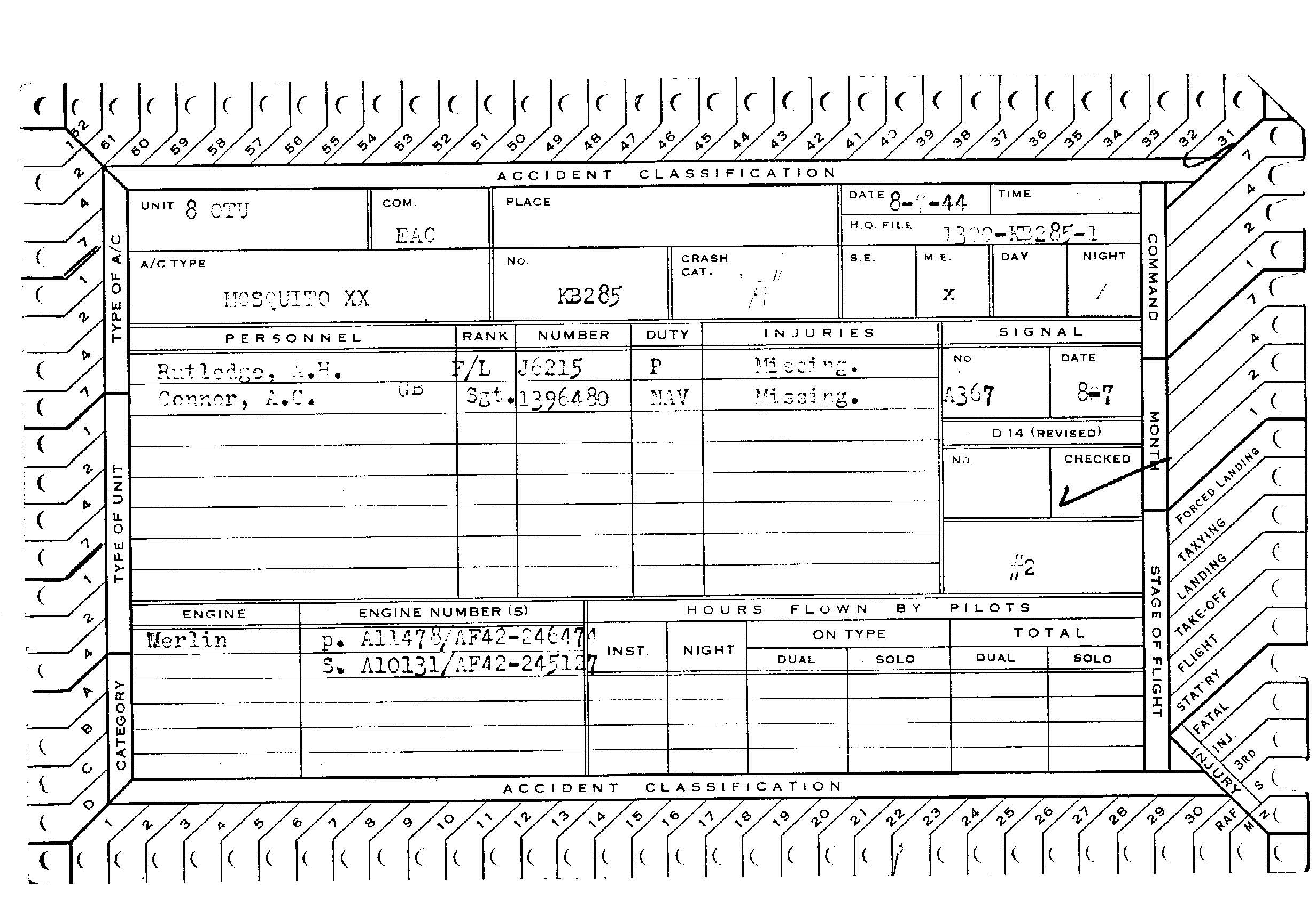
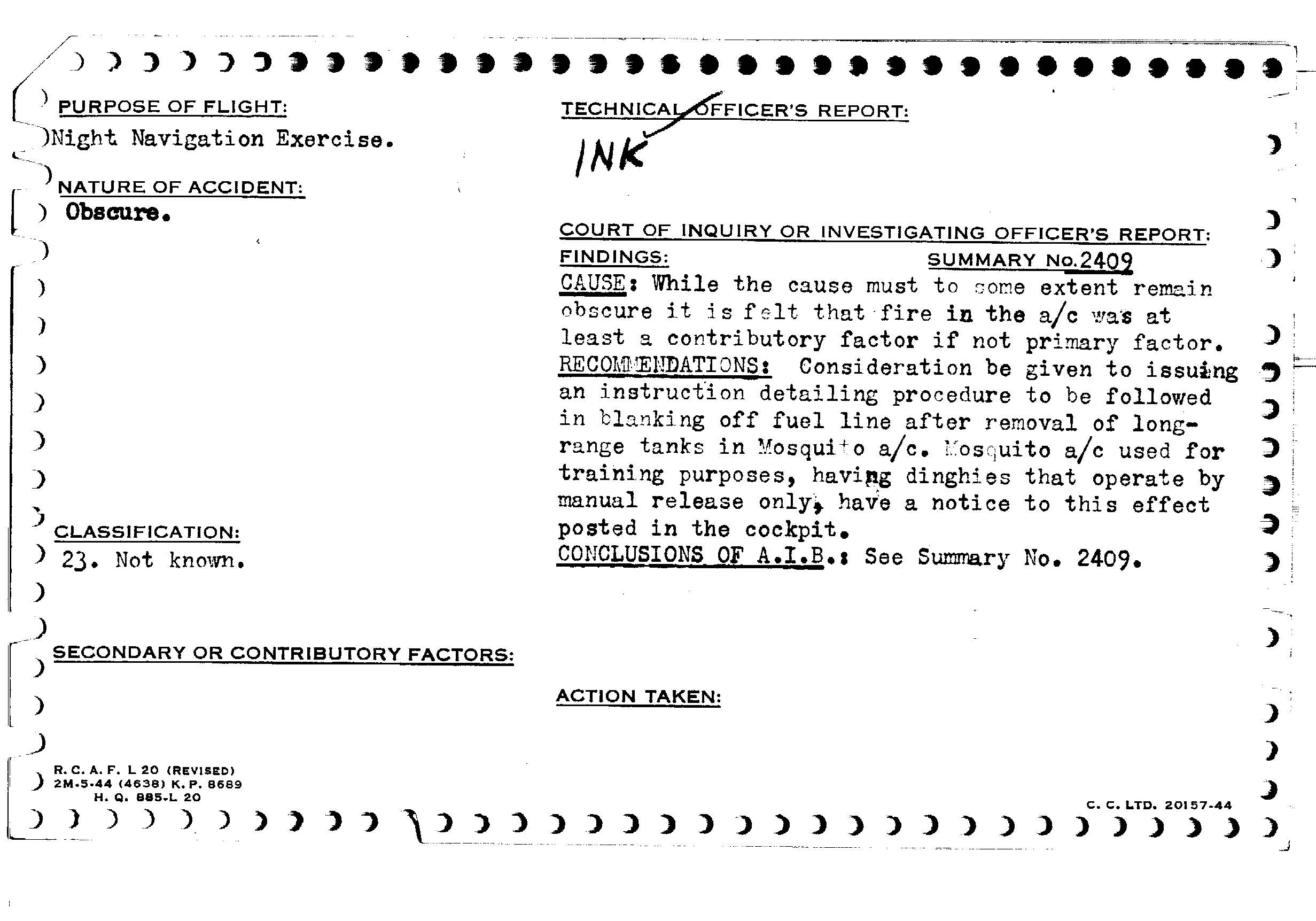
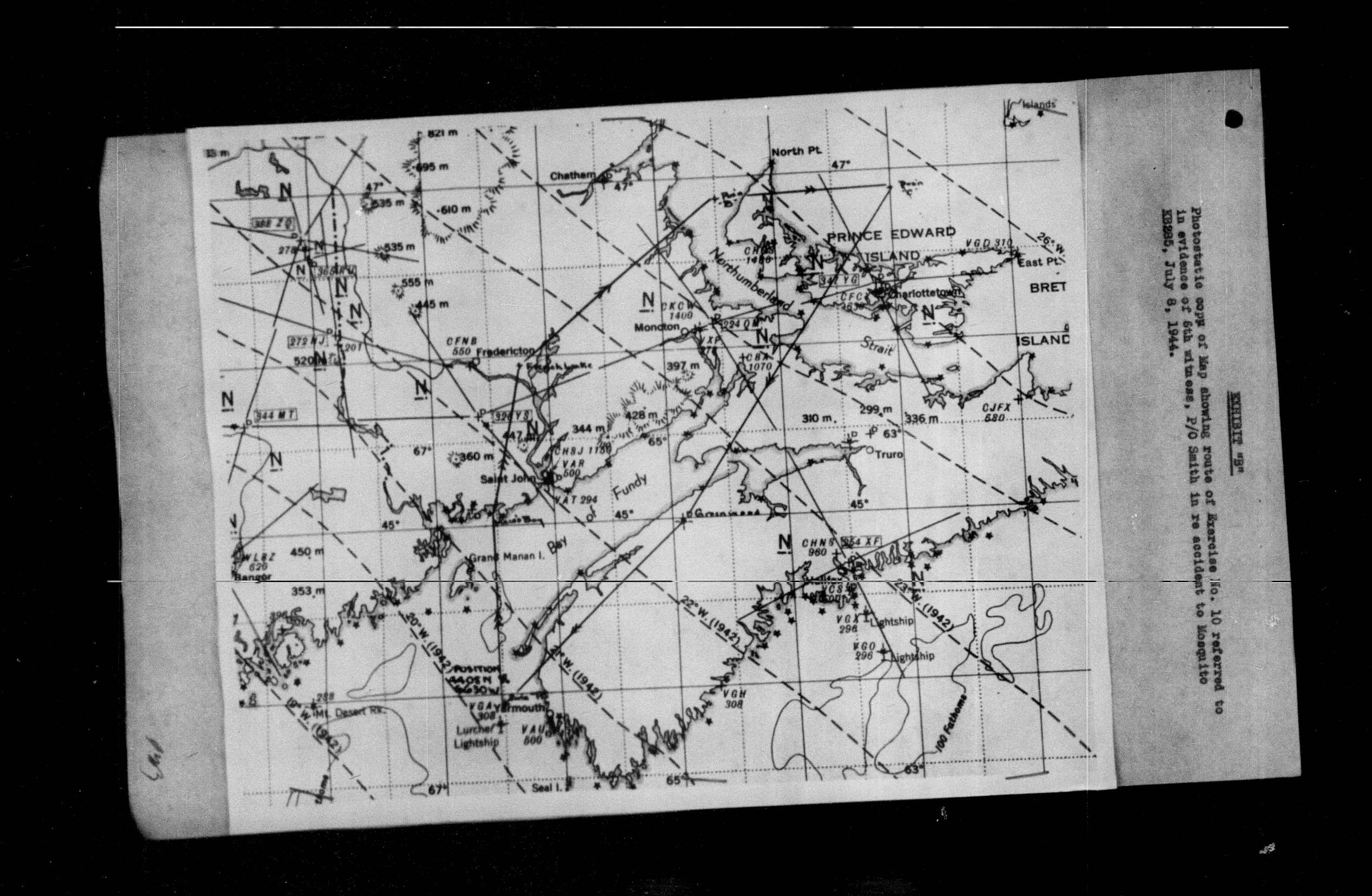
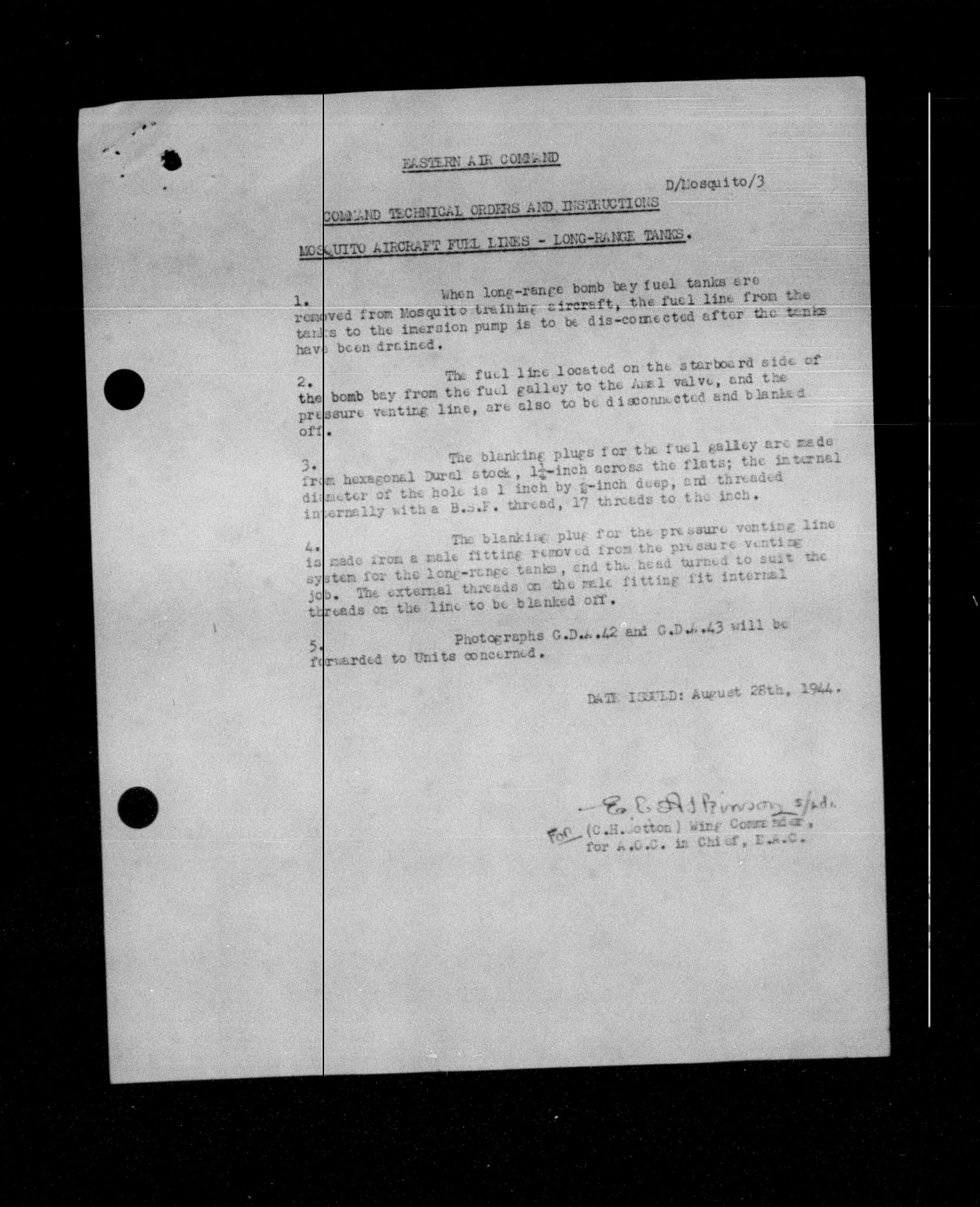
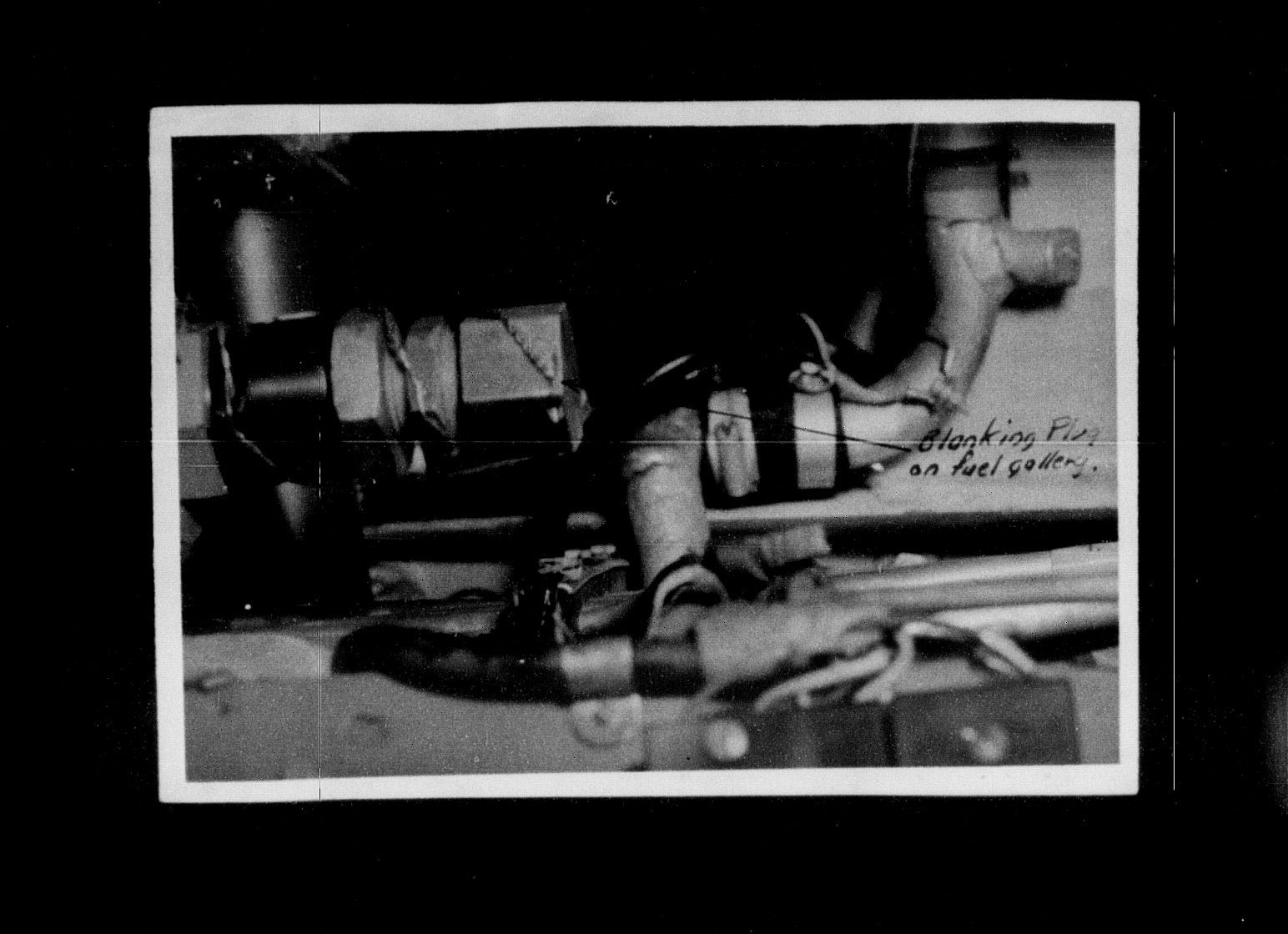
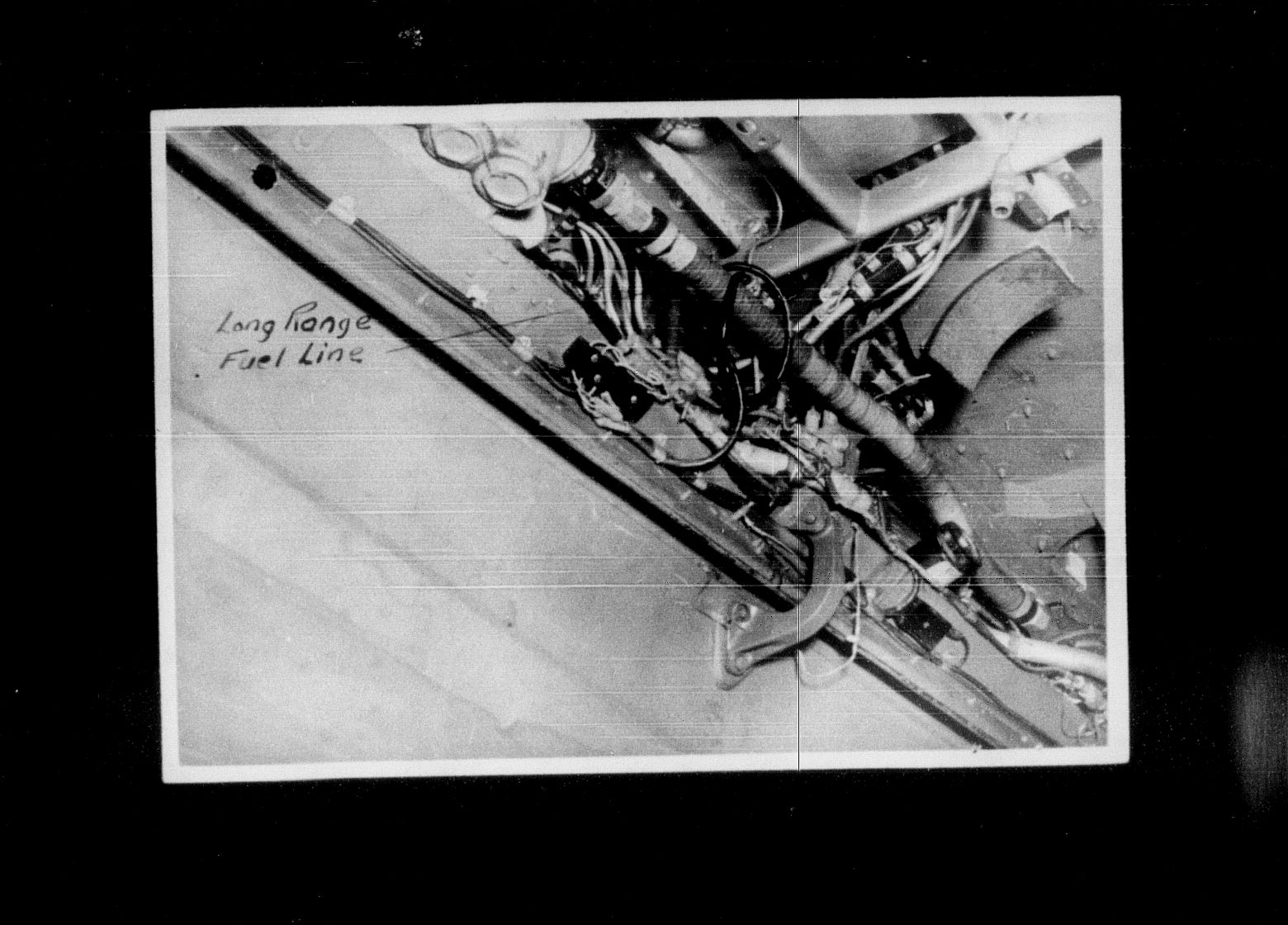
October 23, 1919 - July 8, 1944








Alfred Herbert Rutledge was the son of John Herbert Rutledge (1881-1955), barber, and Anne (nee Drake) Rutledge (1887-1970) of London, Ontario. He had older two sisters, Alma Irene Jacobs (1909-1976) and Helen Rose McKerlie (1911-2001). The attended the United Church.
Alfred had attended Progressive Business School, 1937-1938, studying accountancy. He had started out as a service station attendant, holding numerous positions in the office, then had been doing accounting in the stock department at [White Rose] Canadian Oil Co. Ltd., Divisional Office from 1937 to 1940, prior to his enlistment with the RCAF in July 1940; he was accepted October 24, 1940. Alfred was “assured previous position. I may like to stay In the RCAF as pilot, depending on physical conditions.” He had previous military experience in the Cadet Corps, 1928-1931 in charge of stores. In 1931, he was the quartermaster. He liked bowling, baseball, tennis, hunting, and rowing. His hobby was stamp collecting. He stood 5’10” tall, weighing 152 pounds. He had blue eyes and brown hair, with a fair complexion. He smoked twenty cigarettes a day and drank one quart of beer a week. A scar on the back of his right hand was noted, as was an abdomenal scar (appendectomy).
Alfred began his journey through the BCATP at No. 2 Manning Depot, Brandon, Manitoba, October 24 to November 27, 1940. He was then at No. 34 SFTS, Medicine Hat, Alberta and then at No. 4 TC, Regina doing guard duty until he was sent to No. 2 ITS, Regina, Saskatchewan. “Good type. Quiet, cheerful, and alert.” He was 84th out of 165 men, with 73%.
He was at No. 2 EFTS, Fort William, Ontario from February 2 to April 20, 1941. “Above average ability as a pilot. Satisfactory progress. Keen and enthusiastic. While a trifle slow on the uptake, instructor well satisfied.” GROUND: “80.5%. 20th out of 25 in class. Suitable for commissioned rank. Above average ability, conduct good. Quite confident and unassuming manner.” He was recommended for a fighter squadron. “Has worked well and made steady progress.”
Alfred married Dorothy Lynn Graham (1920-2005) on May 2, 1941, in London, Ontario. Alfred and Dorothy had a son, Frederick Alfred Rutledge, born on April 16, 1943. [Dorothy married Burton Edward Simms (1915-1996).]
He was then at No. 32 SFTS, Moose Jaw, Saskatchewan, May 4 – July 14, 1941. “Has made steady progress – is keen and with a little more confidence and experience should be above average; sound Navigation. GROUND: A keen pupil who has reached a good standard.”
He had taken an instructor’s course at CFS Trenton, Ontario from August 19 to October 6, 1941. “Slightly weak on single engine procedure and manner should be more forceful.”
At No. 16 EFTS, Hagersville, Ontario, Alfred was instructing since October 23, 1941. November 22, 1941: “P/O Rutledge has hardly been here long enough to be ‘vetted’ accurately, but he appears an average, pleasant, keen, young flying instructor. February 2, 1942: “Average pilot. Instrument flying average. This instructor has average flying ability but should improve his knowledge of advanced sequence. Voice: Strong. Manner: Confident. Ability to impart knowledge: Average. Sequence: Good.” September 22, 1942: “This Officer was acting Flight Commander for a short time carrying out these duties very efficiently. Draw to the Officer’s attention, to take a more mature view of the Service and his responsibilities.” Alfred was at the station hospital from September 18 – 28, 1942.
He was taken on strength at RCAF Station, Mt. View. April 20, 1943: “F/O Rutledge is a most keen and energetic officer who carries out his duties in a capable and efficient manner…should make a definite success of his new posting…deportment and discipline good.” June 2, 1943: “F/O Rutledge is very keen and enthusiastic and has done considerable work in advancing pilot bomber training at SFTS’s. It is recommended he be promoted to Acting F/L in accordance with the establishment he fills in the Armament Visiting Flight. Promotion recommended, provided it is concurred in by the Directorate of Training (T Arm) in AFHQ.” November 19, 1943: “…it is known that F/L Rutledge’s services have been quite satisfactory. W/C Erickson would not hesitate to recommend F/L Rutledge for retention of acting rank and ordinary promotion; the basic reasons for submitting an R.211 on completion of four months acting rank.”
Then Alfred was at RCAF Station, Trenton, Ontario. March 31, 1944: “This officer has been posted because of a change of the visiting Flt. Establishment. His work with this unit has been entirely satisfactory…. If necessary, for merit standing an average assessment…would be satisfactory. His duties required him to be on the move from unit to unit continually.” Alfred had 1511 hours total flying including Tiger Moth, Harvard, Fleet, Cornell, Lockheed, Crane, Oxford, Anson, and the Mosquito (total: 36.45 hours, solo 29.45 hours).
Alfred was posted to No. 8 and No. 36 O.T.U. Greenwood, Nova Scotia by the late spring of 1944. During a night navigation exercise on July 8, 1944, Alfred and his navigator and wireless operator, Sgt. Anthony Cordery Connor, 1396480, RAFVR were killed as their aircraft caught fire and crashed into the sea on the western end of the Bay of Fundy. On the crash card: “While the cause to some extent remain obscure, it is felt that fire in the a/c was at least a contributory factor if not primary factor. RECOMMENDATIONS: Consideration be given to issuing an instruction detailing procedure to be followed in blanking off fuel line after removal of long-range tanks in Mosquito a/c. Mosquito a/c used for training purposes, having dinghies that operate by manual release only, have a notice to this effect posted in the cockpit.”
The Court of Inquiry can be found on microfiche C-5938, starting at image 2132. It was held each day from July 10 – 17, 1944, with fourteen witnesses called and photos including one of the starboard mainplane, a dinghy, inner starboard wing, and another of burned pieces of wreckage. A copy of the proposed route was also included.
Excerpts: The first witness, F/L M. F. Wynn Willson, RAF, 89625, Senior Gunnery Officer at No. 8 O.T.U., Greenwood, NS stated that he was in charge of night flying, and he authorized F/L Rutledge as pilot and Sgt Connor as navigator in Mosquito KB285. “The flight was to be a night navigation exercise No. 10 and searchlight practice on return. I saw this aircraft airborne and in no difficulty at 0343 GMT. I attended the briefing for all pilots and navigators on this exercise which to my knowledge, was complete in every detail. F/L Rutledge had completed his seventh week of flying Mosquitos at this Unit. Having had him through my flight the previous week, he appeared to be a fully competent and able pilot on Mosquito aircraft. I had previously seen him take a Mosquito around the circuit again on one engine with wheels down which is a difficult undertaking. The pupils are to return to Base by the shortest route. Four other aircraft were on this particular detail at the height of 3,000 feet.”
The second witness, F/L A. G. Lawrence, J6409, Flight Commander “C” Flight. “On two different occasions I gave F/L Rutledge dual at night totalling two hours and found him to be a good average pilot, alert, and quite capable. He had a great deal of flying expert and impressed me as a quiet type not apt to panic. A pilot at this station is usually given one and a half to two hours of dual at night. A minimum of two hours solo is required prior to carrying out a navigation on a night cross country flight. In this case, F/L Rutledge had 2 ½ hours night solo prior to his first night cross country. He signed the flying orders, indicating he read them. The fuel capacity of the Mosquito aircraft: all tanks 546 gallons. In the outers, there are 118 gallons. Cruising at about 240 mph under normal circumstances, the hourly rate of fuel consumption is around 100 gallons per hour. If a pilot used his outers only, he would remain airborne just over an hour.”
The third witness, F/L R. G. Macey, RAF, 75653, Operations Fighter Control Officer, stated that four Mosquito aircraft, KB107, KB174, KB243, and KB285 were detailed for night navigational exercise No. 10, being of three hours’ duration consisting of 2:20 navigation and the rest searchlight exercises on completion of the navigational trip….”The pilot of KB285 tested his RT and the navigator his WT channels whilst over Base and I found them satisfactory whereupon the pilot was permitted to set course at 0355 GMT. The aircraft track was plotted by DR means on the operations table. No WT position reports were received from this aircraft which was due back from the exercise at 0614 GMT. At 0439 GMT, routine RT calls were made to KB 285 who at that time would be crossing the Bay of Fundy from Yarmouth to Mace’s Bay in a northerly direction and in fact the plots from Command Filter Room were identical with the DR tracks of the aircraft on this exercise. No reply was received and the calls were repeated at 0443 GMT and again no reply, but aircraft KB243 replied saying, ‘Do you wish me to contact Salvo 107?’ Salvo 107 was the call sign of aircraft KB 285, to which I replied, ‘Yes, ascertain his position.’ KB243 was heard endeavouring to make contact, with but without success. KB243 was then instructed by me that there was an aircraft circling Mace’s Bay which might be KB285 and KB243 replied, ‘Yes it must be him as he is just ahead of me.’ On subsequent discussion, this latter statement appears to be a guess as KB107 was in fact circling Mace’s Bay in an effort to make contact with Base. KB 43 formed the impression that KB 285 was ahead by reason of the fact he overheard the RT conversation when KB 285 set course which was three minutes ahead of himself. This was approximately 0446 GMT. Thence onward numerous RT and WT calls were made in an effort to establish contact without result. At approximately 0650 GMT, CFC were informed and overdue action taken. Navigators are instructed to report position and time at turning points. After all possible sources of communication and information have failed to establish contact or location which usually takes 30 minutes more or less depending on telephone or traffic conditions. This would be after the aircraft’s ETA Base. After aircraft KB285 was given permission to set course there was no more communication made with this aircraft.”
The fourth witness, F/O A.M. Nichol, J24973, student pilot flying Mosquito KB243, stated that he took off shortly before F/L Rutledge. “I heard him on the RT after he was airborne when he stated he was setting course. Actually ,he set course 3 minutes before I did. Subsequently, after I had reached my first turning point and was headed toward Mace’s Bay, I heard F/L Rutledge over the RT call ADAX which is our sector OPS. I did not hear that he had to say or whether he got through. Shortly after, ADAX asked me to contact KB 285. I called F/L Rutledge and he answered me but when I called again I received no further reply. At 0483 GMT, I heard F/L Rutledge called ADAX giving his height as 6000 feet. I set course at Mace's Bay at 044 for GMT for French Lake and about 3 minutes later, I heard F/L Rutledge calling ADAX. As he was not getting through, I tried to contact him without success. I heard nothing further from him though I myself had no difficulty contacting base. At one time prior to reaching Mace’s Bay, I advised ADAX that F/L Rutledge was just ahead of me but my only reason for saying this was because he had preceded me on setting course from Base… F/L Rutledge might have climbed to 6000 feet because if he was unable to make RT contact with Base at 3000 feet he would climb and try to get through at a higher altitude. My instructions were to takeoff on the outer tanks and fly for 20 minutes then switch to the main supply. The flying conditions were almost a full moon, hazy, with no horizon but generally good conditions. I did not hear or see any distress signals that night.” The fifth witness, F/L G. J. A. Mason, RAF, 48845 concurred that gaining height would increase the range.
The sixth witness, P/O A. L. Smith, RAF, 161689, Navigation Instructor, stated that he told the crew of Mosquito KB285 to fly at 3,000 feet and at a cruising speed of 240 mph and to report their position at turning points by WT on Base frequency. I explained the route to them which was the same route they had flown on a day exercise. “Sgt. Connor was slow at first but would be considered average at the time of this flight. About 50 minutes’ flying time is required to reach Mace’s Bay.”
The eighth witness, F/O O. H. Bell, RAF, 53150, stated that he found Sgt. Connor “an average Navigator as far as air operations were concerned but felt he needed further experience. From the exercises on which he had flown, he proved to be a fair operator. On recently taking his graduating practical examination, his results were the best in his squad, and he should have had no difficulty in coping with the wireless phase on the navigational trip from which he is missing.”
The ninth witness, Sgt A. J. Monaghan, aeroengine mechanic stated that “I may add that the Pilot, F/L Rutledge, had flown aircraft KB285 in its FT and had stated that he would like to have it for his night exercises as he said he felt it was a very good aircraft.”
The tenth witness, F/O T. K. Wotherspoon, C35389, Flying Control Officer stated that he gave the pilot permission to change to Channel D for Day which is Sector Operations Channel. “I heard nothing more on this aircraft until he was reported overdue by sector operations who notified Command Flying Control. Subsequently, on July 10th 1944, a message was received at the station from command flying control at 1535 hours GMT that a Canso aircraft from Yarmouth had located a wing of an aircraft... this wreckage was cited at 1520 hours GMT July 10th 1944. This wing arrived at the station on the afternoon of July 11th 1944 and I was advised that it was the wing of a Mosquito aircraft.”
The thirteenth witness, F/O A. C. Maskell, C25623, Technical Adjutant stated, “On July 11th 1944, there arrived at this unity section of the starboard main plane of a Mosquito aircraft, bearing a serial number 478 which was picked up... July 10th 1944. I subsequently identified as coming from aircraft KB285, after contacting de Havilland Aircraft Limited. On Tuesday July 11th 1944, a dinghy, number 539 was picked up 7 miles south of Brier Island at the tip of Digby Neck. I was informed it was not inflated when picked up in the sea by a fisherman. To date, the dinghies on the station have not been marked nor the serial number recorded but steps have now been taken to remedy this. It appears from examination of this dinghy that the CO2 bottle had broken away from the dinghy connection by impact. Aircraft KB285 arrived at this unit on May 22nd, 1944 and acceptance check was made on the 23rd of May, however, the dinghy was not removed nor examined, it having been examined for dinghy special inspection M.5 at the contractor’s. This aircraft had not reached its second minor inspection period at which this time the dinghy would be removed. This particular dinghy was L type as fitted to Mosquito aircraft and from examination of the metal parts, I would say it had not been in the water for a period exceeding five days and this, together with the fact that it was found in the same area as the identified wing, it must be presumed it came from aircraft KB285. The burns appeared in several places on the dinghy, but when repacked in accordance with the instructions for this type of dinghy, it was found that the burns appeared in one area, at the rear of the packing box only. This would suggest that this dinghy had been burned while still intact in the aircraft. The dinghy strongbox is located immediately behind the cockpit canopy and ahead of #3 bulkhead. On reports being received that further wreckage had been washed ashore on the south shore of Brier Island, I preceded on July 14th, 1944 with the Investigating Officer to that area in an attempt to identify the recovered parts. With the assistance of others, we recovered numerous small pieces of a Mosquito aircraft, these pieces not having been in the water for any great length of time.... Part of the inner starboard wing top plywood covering, which was found on the south shore of Brier Island. It showed no evidence of being burnt. During the day, approximately 15 miles of shoreline was covered during which time numerous small unidentified pieces of a Mosquito aircraft were found. A few burnt pieces were also recovered.... showing these burnt pieces whose location was later established on the aircraft is coming from the fuselage in the area of the dinghy storage box, the bomb bay doors, and the rear entrance door. Mosquito KB285 had flown 47 hours and 30 minutes. From viewing the recovered burnt pieces, it is my opinion that fire had developed in the aircraft in the vicinity of the dinghy storage box and bomb doors. No bombs or other armament were carried on this aircraft. The aircraft are received with long range bomb bay tanks, fitted but are removed by the unit as they are not thought necessary for training as carried out here. The tanks are removed this way: the fuel line from these tanks to the immersion pump is disconnected after the tanks have been drained and the tanks and supporting straps are removed from the airframe and bomb racks. The fuel line is then blanked off. The blanked off fuel line is located in the bomb bay and attached by suitable brackets to the starboard side of the fuselage. The line is located below but in the section of the fuselage containing the dinghy stowage box. There is no definite policy having been adopted as to an absolutely safe method of blanking off this fuel line. Gasoline seepage and marks of gasoline on wood members in the immediate area were evident. The inspection is now in progress in any aircraft whose connection at this point shown signs of leakage is being grounded and a proper blanking plug fitted. The long-range fuel tanks were removed from KB285 on May 23rd 1944 and had blanking plugs fitted but as the personnel who carried out this work have been repatriated I have been unable to ascertain the type of blanking plug fitted or the method used in fitting. It is in my opinion that any fire that took place in KB285 occurred in the air because parts of the aircraft on which burn marks were definitely found would come into direct contact with the water on any type of emergency ditching. Also due to the burned condition of the dinghy, it was necessary for the dinghy stowage box to burn first before the dinghy would come into contact with the flames and this would be unlikely if the aircraft were in the water. While there is evidence that the aircraft apparently disintegrated due to the numerous small pieces of the entire section washed ashore, it cannot be definitely stated whether this disintegration was due to an explosion in the air or due to the aircraft hitting the water with a terrific impact... I discussed with several fishermen on Brier Island, the movement of the tides in this area and was advised that due to their direction of flow that any wreckage on the surface of the sea would be washed ashore along the south shore of Brier Island and Digby Neck taking approximately 3 to 5 days to do so. I cannot definitely state what caused the fire but feel that it did not originate in the centre section of the aircraft. Due to the fact that aircraft KB285 was tested for night flying by F/L Rutledge and also that he carried out 2 hours and 30 minutes solo night landings prior to his taking off on his navigation exercise and also the fact that the aircraft records were all in order, I would say that the aircraft was serviceable for the flight. This is subject to lack of knowledge of the condition of the dinghy or the blanking plug in the long-range fuel lines.”
The fourteenth witness, W/C Padwich, C3358, DEO, No. 8 O.T.U. stated, “I cannot suggest an origin of the fire not definitely. There is a possibility that gasoline was leaking from the blanked off portion of the long-range tank fuel line. It is not possible to say how the gasoline, if it was present, was ignited. After establishing the fact that the aircraft had been on fire, I made a thorough check of the fuel system of one of the Mosquito aircraft in the hangar. The blanking plug fitted to the long-range tank fuel line was leaking and subsequent examination of all the mosquito aircraft on the station revealed that six had faulty blanking plugs. As the 13th witness has pointed out, it is apparent that no definite policy has been adopted regarding this fitting of blanking plugs. In view of the foregoing, it is within the realm of possibility that aircraft KB285 did have a fuel leak from this source.”
“FINDINGS OF THE COURT: The said aircraft was on fire whilst still in the air, the fire being in the area around the dinghy stowage, the bomb bay doors, and rear entrance door. Maintenance insofar as it relates to Mosquito KB285 was not satisfactory in the following respects: on the acceptance check of the said aircraft on May 23rd, 1944, the dinghy was not then nor at anytime thereafter inspected, checked, or examined. This said dinghy was not marked in accordance with Command Instruction 223 dated June 9th ,1944 RE: marking of emergency equipment. No record of the serial number of said dinghy was kept. Maintenance insofar as it relates to other Mosquito aircraft at No. 8 O.T.U. was not satisfactory in that no definite policy had been adopted regarding the method of fitting of emergency plugs after removal of the long-range fuel tanks. It being found that six aircraft showed signs of gasoline leakage due to faulty blanking plugs. No evidence was available in this respect regarding KB285. CAUSE: While the cause must to some extent remain obscure, it is felt that fire in the aircraft was at least a contributing factor, if not the primary factor. The origin of the fire is uncertain but in view of its location an evidence of faulty blanking plugs in other aircraft causing a gasoline leakage, it is felt that this possibility should not be overlooked. RECOMMENDATIONS: In view of the fact that immediate action was taken on July 16th, 1944 by No. 8 O.T.U. to remedy the omission set out in paragraphs four and five of the Investigating Officer’s findings above, the only recommendation suggested are that (A) Consideration be given to issuing an instruction detailing the procedure to be followed in blanking off the fuel line after removal of the long range tanks in Mosquito aircraft. (B) Mosquito aircraft used for training purposes having dinghies that operate by manual release only, have a notice to this effect posted in the cockpit.”
A letter dated September 22, 1944: “It is most unfortunate that the accident occurred during the transition period from RAF to RCAF as this has made it extremely difficult to determine just who was responsible for authorizing the methods used for blanking off the fuel lines. In view of this and the fact that the Command has taken the corrective action necessary, it is considered that there is nothing to be gained in further pursuing this with the Command.”
Alfred had $400 in Victory Loan Bonds and three $100 bonds partly paid for through the RCAF. He had two life insurance policies worth $3,100 and owned a 1941 Plymouth coupe, worth $600. Dorothy wrote on the Estates form: “No. 2 policy will not be paid due to war clause in policy. I will get no insurance whatsoever, as F/L Rutledge was killed in an aeroplane crash while in his Majesty’s service. Alfred H. Rutledge’s mother, Annie Rutledge, balance on hand $618.67. Yes, I wish this administered with the pay account…could you please inform me what will happen to the three bonds which are partly paid for through the RCAF?”
Alfred is remembered on the Ottawa Memorial as well as on his parents’ headstone at the Woodland Cemetery in London, Ontario.
LINKS: